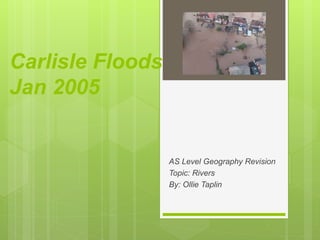Carlisle floods jan 2005
- 1. Carlisle Floods Jan 2005 AS Level Geography Revision Topic: Rivers By: Ollie Taplin
- 3. Carlisle's location ÔÇõ Carlisle is situated on the flood plain of the River Eden with three rivers meeting in the city. ÔÇõ The catchment is made up of the Rivers Eden, Eamont, Irthing, Petteril and the Caldew, as well as smaller rivers and streams draining into the Eden estuary. ÔÇõ The catchment covers approximately 2400km2 and is home to approximately 244,000 people. ÔÇõ The catchment is mainly rural, with only 1% classified as urban: the main urban areas are Carlisle, Penrith and Appleby. ÔÇõ Carlisle has a history of flooding with flood events recorded as far back as the 1700s. In recent years there have been significant floods in 1963, 1968, 1979, 1980, 1984, and recently in 2005.
- 4. Carlisle’s location This map shows the area around Carlisle and the three rivers that meet in the city. The largest being the river Eden
- 5. Carlisle's location This map shows the catchment area of the river Eden. Carlisle is represented by the circle. As you can see it sits in the middle of the wettest area of Cumbria.
- 7. Causes of the Carlisle flood Rainfall Rainfall was very high for the period 6th to 8th January, during which two months' worth of rainfall were released in 24 hours. However, it followed a month of high rainfall in the Carlisle area, so the ground was saturated and would no longer allow water to infiltrate, and surface run-off was excessive. The result was rapidly rising water levels in a number of rivers ( Eden, Kent and Derwent ) ÔÇõ 67% of the flooding resulted from rivers and watercourses ÔÇõ 25% of flooding was caused by surface water ÔÇõ 8% was due to flooding from sewage and infrastructure failures.
- 8. Rainfall
- 9. Causes of the Carlisle flood Physical ÔÇõ Low lying flood plain less than 20m ÔÇõ Many tributaries joining the Eden e.g. River Petteril ÔÇõ Lack of vegetation limits interception rates. ÔÇõ Higher than average rainfall ÔÇõ High drainage density
- 10. Causes of the Carlisle flood Human ÔÇõ Homes built on the floodplain (wet point site) Edentown ÔÇõ Levees along river banks may have been artificially strengthened ÔÇõ Recreational activities deliberately built on the floodplain e.g. golf course ÔÇõ Impermeable surfaces increasing surface run-off created by the urban environment of Carlisle. ÔÇõ Sewage works
- 12. Impacts of the Carlisle flood  Across the catchment, the January 2005 flooding affected 2,700 homes  In Carlisle three people died  The cost of the flooding was estimated at over £400 million.  50% of residents in the flood risk area had not signed up to receive a warning.  The area immediately to the south of the River Eden was worst affected, where the floodplain had been used for development.  flood waters neared the second floors of a few houses, leaving residents stranded- Evacuation was dangerous in darkness and high winds  2.5 metres of water flooded the fire station and police station adding to the problem of help by these services.
- 14. Responses Immediate ÔÇõ Evacuation of people from buildings was undertaken as best as emergency services could. ÔÇõ Use of private boats for transport was used ÔÇõ Large relief centres set up for those whose homes were destroyed by the floods. ÔÇõ Rapid response by sewage companies in the area to try and limit spillages.
- 15. Responses Long term Cost benefit scheme Flood management scheme Engineering solutions Flood risk assessments
- 16. AS Level Geography Revision Topic: Rivers By: Ollie Taplin The End
















